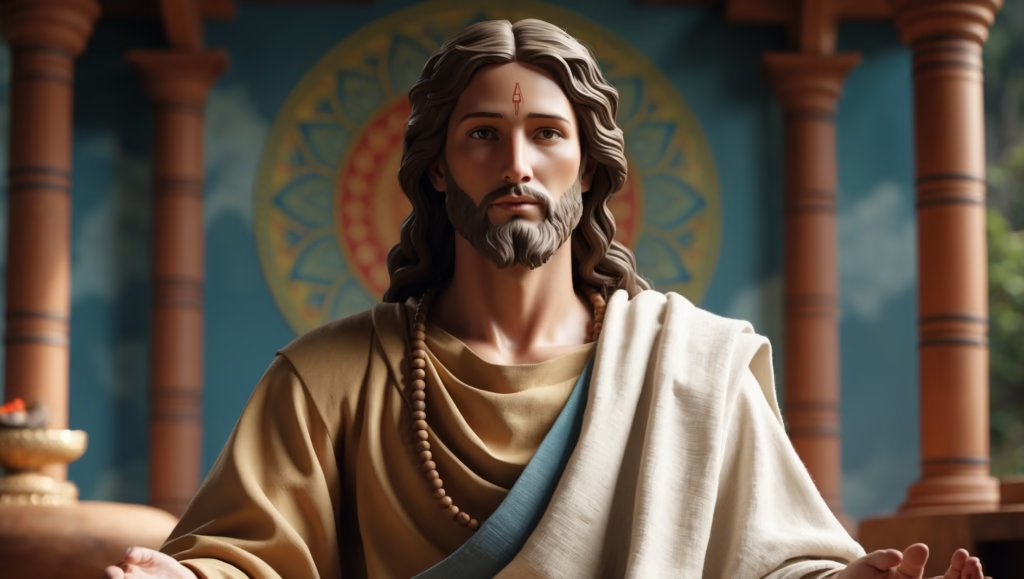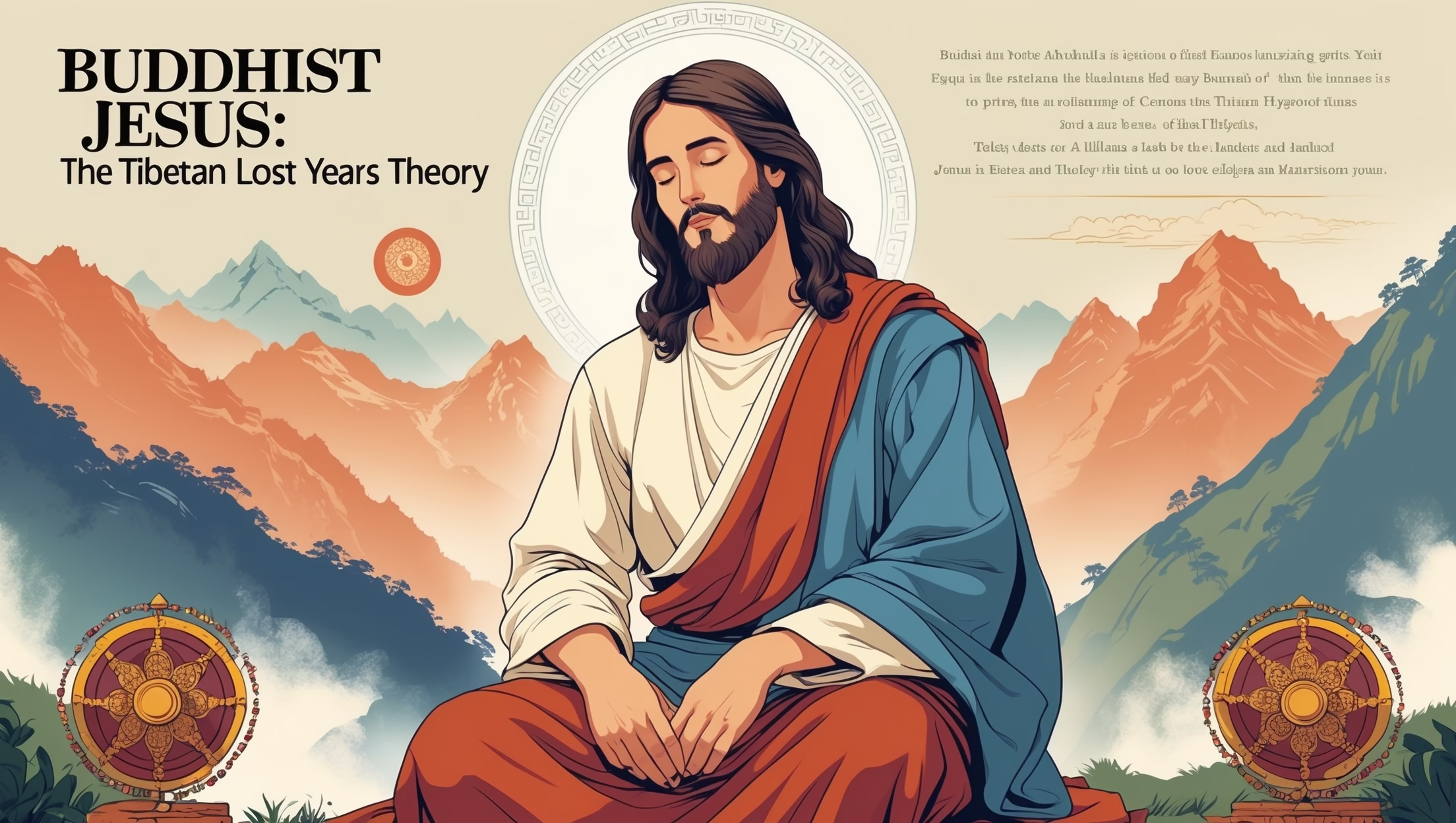Examining the “Issa” Manuscripts and Cross-Cultural Connections
The years between Jesus’ childhood and the beginning of His public ministry—sometimes called the “lost years”—have long captivated scholars, theologians, and enthusiasts. While the Gospels are silent on the period between age twelve and thirty, some theories suggest that Jesus traveled far beyond Palestine, encountering diverse cultures and religious traditions. Among the most famous is the Tibetan or Buddhist Jesus theory, popularized by the 19th-century Russian journalist Nicolas Notovitch, who claimed to have discovered manuscripts recounting the life of a young Jesus in India and Tibet.

The Notovitch Controversy
1887 Discovery Claim
Notovitch reported that during a visit to the Hemis Monastery in Ladakh, Northern India, he encountered documents describing the travels of a figure called “Saint Issa”, whose teachings resembled those later attributed to Jesus. The manuscripts allegedly chronicled:
- His travels across India and Tibet
- Encounters with Buddhist teachers
- Ethical and spiritual instruction echoing the Sermon on the Mount
- Miraculous deeds, such as walking on rivers and healing the sick
Modern Analysis
Subsequent investigations by scholars, including J. Archibald Douglas in the late 19th century, found no evidence of the manuscripts’ existence. Carbon dating and textual analysis indicate that the documents are likely modern fabrications or misattributions. Critics argue that Notovitch may have fabricated the account, either for personal fame or due to miscommunication with local monks.
However, historical context suggests that early Buddhist-Christian interactions were plausible. Trade routes connecting Alexandria, India, and Central Asia—part of the broader Silk Road network—facilitated cultural and religious exchanges between Jewish, Christian, and Buddhist communities. While Notovitch’s claims remain unverified, they highlight a genuine phenomenon of cross-cultural dialogue in the first centuries CE.
Fascinating Parallels Between Jesus and Buddhist Teachings
Even if the manuscripts are not authentic, comparisons between Jesus’ teachings and Buddhist philosophy reveal striking thematic overlaps.
1. Compassion and Ethical Conduct
- Jesus: The Sermon on the Mount (Matthew 5–7) emphasizes love for enemies, humility, and care for the poor.
- Buddha: The Metta Sutta (Loving-Kindness Discourse) advocates universal goodwill, non-harm, and compassionate action toward all beings.
Both traditions elevate ethical responsibility, advocating a life of selflessness and moral integrity. While likely independent, these convergences suggest universal spiritual insights across cultures.
2. Miraculous Elements
- Jesus: Walking on water (Mark 6:45–52), calming storms (Mark 4:35–41)
- Buddha: River crossings and other miracle narratives in Pali Canon texts
- Both figures employ miracles to demonstrate authority, compassion, and teaching power, though the theological framing differs.
3. Temptation Narratives
- Jesus: The wilderness temptation (Matthew 4:1–11) tests obedience and spiritual integrity.
- Buddha: Mara’s temptations before enlightenment challenge attachment, desire, and fear.
In both cases, the narrative emphasizes resisting worldly distractions to achieve a higher purpose, illustrating universal moral archetypes.
Scholarly Perspectives
Modern scholars largely reject the literal historicity of the Tibetan Jesus manuscripts. Dr. Elaine Pagels notes:
“Cultural convergence, not direct borrowing, explains the similarities between Buddhist and Christian ethical teachings. Both reflect universal human concerns about suffering, compassion, and moral integrity.”
Other scholars emphasize that while Jesus almost certainly remained in the Levant for much of His life, cross-cultural trade and philosophical exchange could have exposed Palestinian communities to Buddhist ideas, albeit indirectly.
Modern Impact and Cultural Reception
Despite its dubious historicity, the idea of a Buddhist Jesus has inspired creative spiritual and cultural exploration:
- Tibetan Christians sometimes integrate traditional Buddhist practices, such as prayer wheels or mandalas, with Christian devotion.
- The Dalai Lama has commented favorably on Jesus’ ethical teachings, highlighting cross-religious respect and dialogue.
- Popular media, novels, and documentaries continue to explore the “lost years,” sparking public interest in interfaith and historical inquiry.
This phenomenon illustrates that even speculative narratives can foster meaningful reflection on the universality of Jesus’ moral and spiritual example.
Theological Implications
- Jesus as a Global Teacher
While historical evidence for Indian or Tibetan travel is lacking, the parallels encourage viewing Jesus’ message as transcending cultural and geographic boundaries. - Interfaith Dialogue
Comparisons between Jesus and Buddha invite conversations about ethics, compassion, and human flourishing across religious traditions. Such dialogue can reduce sectarian tension and promote global spiritual literacy. - Mystery and Faith
The “lost years” remind believers and scholars that Scripture may prioritize theological meaning over chronological detail. Questions about Jesus’ early life encourage humility and a sense of wonder in religious study.
Conclusion
The Tibetan Lost Years Theory—centered on Notovitch’s “Issa” manuscripts—remains a controversial and largely discredited claim. Yet, it has enduring value as a lens for exploring cross-cultural connections, spiritual parallels, and the universal appeal of Jesus’ teachings. From the Sermon on the Mount to the Metta Sutta, from walking on water to resisting temptation, the narrative threads reveal shared human aspirations for compassion, moral courage, and transcendence.
Even in the absence of historical proof, the concept of a Buddhist Jesus stimulates reflection, artistic expression, and interfaith dialogue. As Tibetan Christians blend prayer wheels with crosses or as scholars compare ethical teachings across continents, the story of Jesus—both historical and imaginative—continues to inspire creativity, moral reflection, and global religious literacy.
Focus Keywords:
Buddhist Jesus, Tibetan Lost Years, Saint Issa, Nicolas Notovitch, Cross-Cultural Christianity, Jesus in India, Metta Sutta, Sermon on the Mount, Interfaith Dialogue, Historical Jesus








